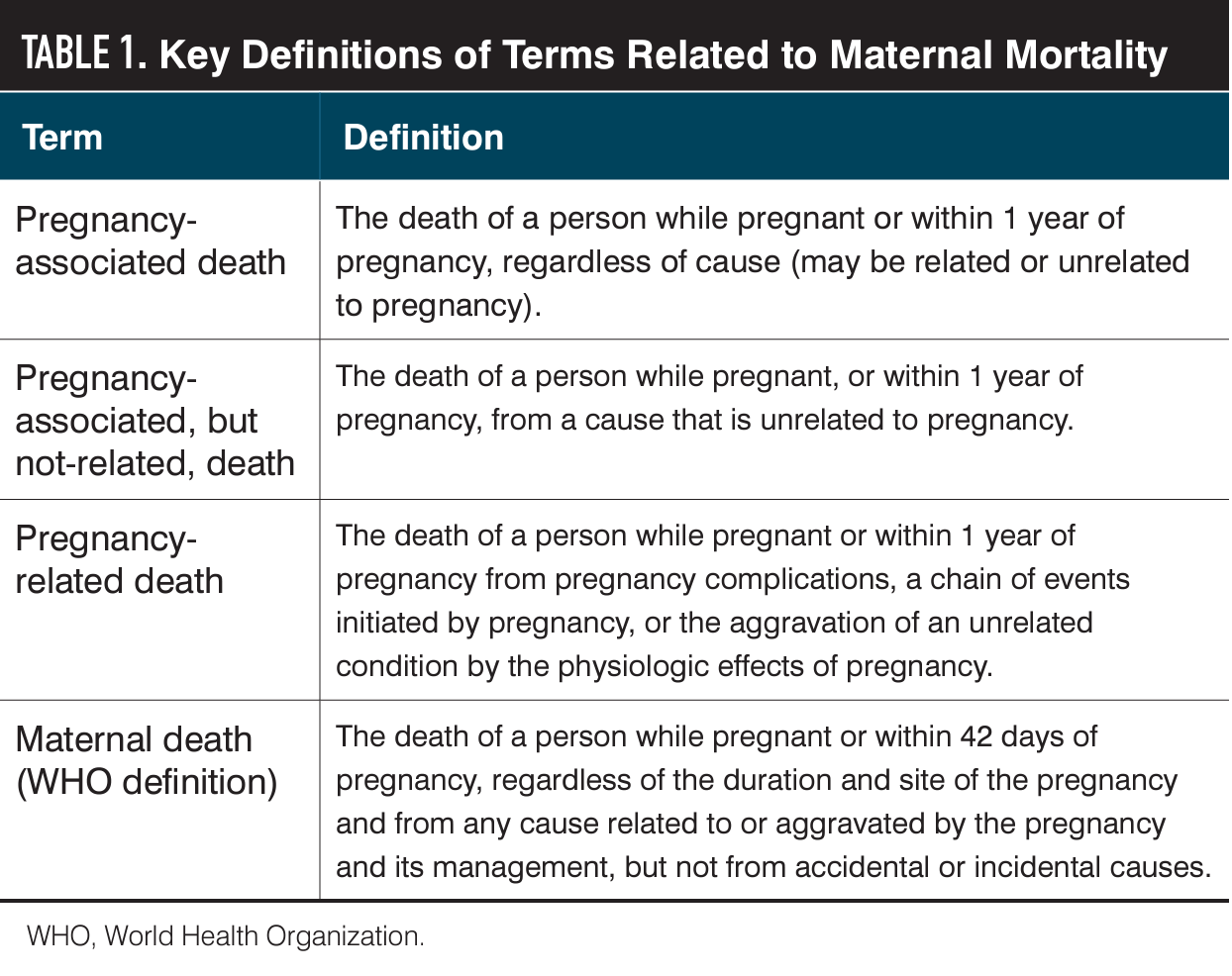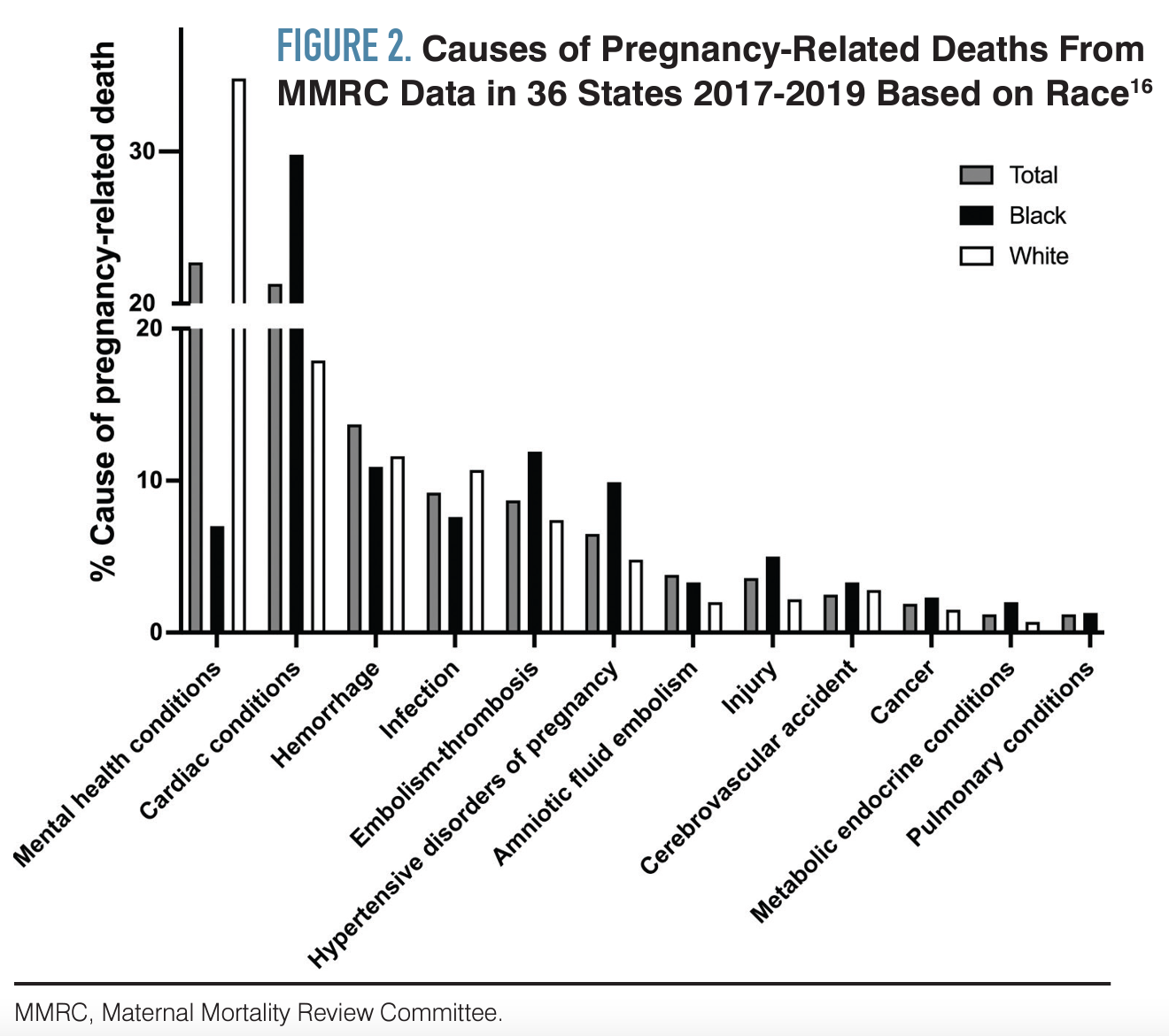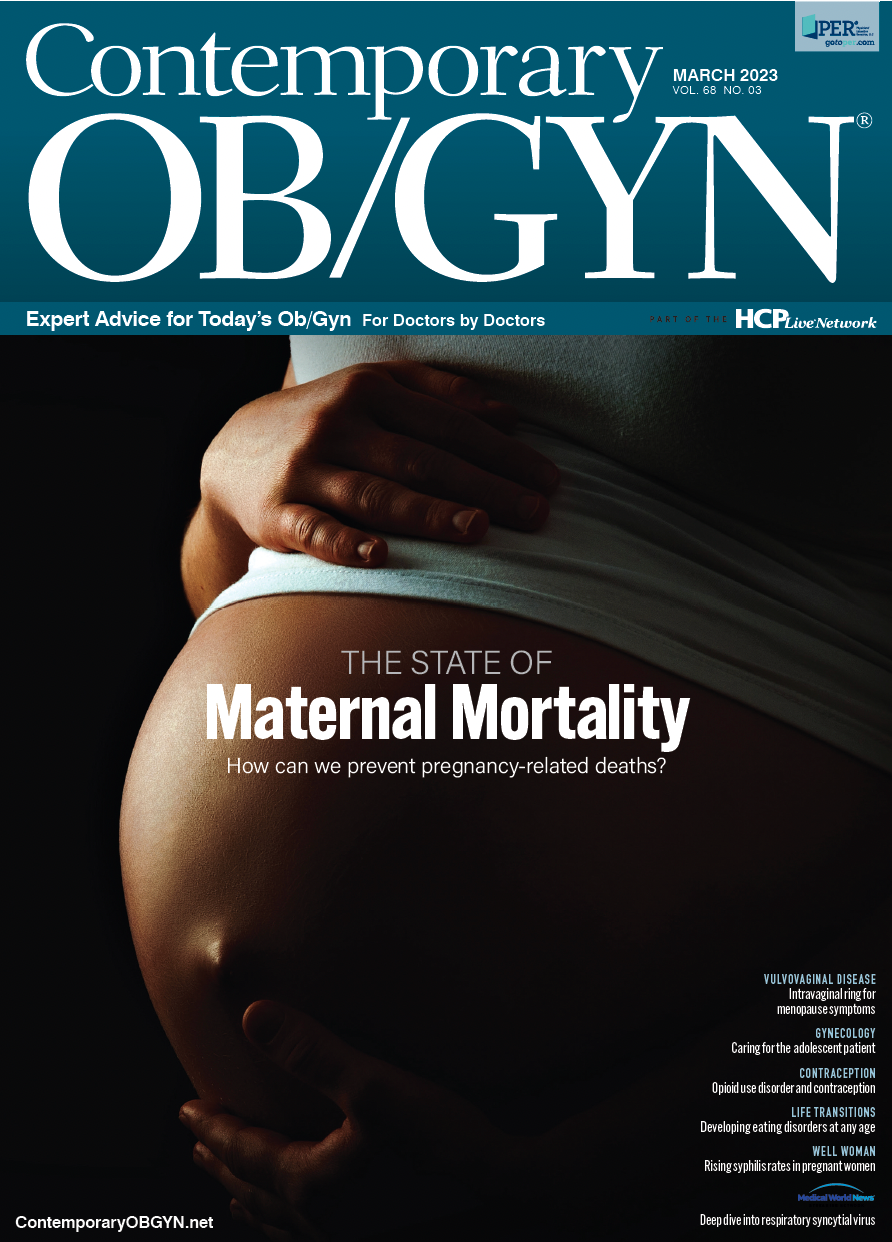
How can we prevent pregnancy-related deaths?
Interventions before and after birth can reduce the rising maternal mortality ratio.
Adobe Stock/JenkoAtaman

The United States is facing a grim reality in maternal health. In 2020, more than 800 women died in the United States from pregnancy-related complications,1 and this number continues to grow. The maternal mortality ratio (MMR) in 2020 was 23.8 deaths per 100,000 live births compared with 20.1 in 2019.1,2 The ratio of pregnancy-related deaths in the US is in stark contrast to other high-income countries where pregnancy-related deaths are declining.3 By highlighting some of the challenges of current data collection and reviewing contemporary data trends, we can pinpoint gaps in health care and focus on measures that make a tangible positive impact on maternal health outcomes.
Issues with data collection
Table 1. Key Definitions of Terms Related to Maternal Mortality

The World Health Organization (WHO) defines the maternal mortality ratio as the number of maternal deaths per 100,000 live births within 42 days of pregnancy termination, regardless of the cause of death.3 Although MMR is a commonly used indicator for international comparisons of maternal health, it is unknown what proportion of the mortality ratio is related to pregnancy. The CDC subcategorizes pregnancy death as related to or associated with the pregnancy within 1 year of pregnancy, regardless of pregnancy duration or location. A pregnancy-associated death is defined as the death of an individual while pregnant or within 1 year of pregnancy regardless of cause. A pregnancy-related death is defined as the death of an individual while pregnant or within 1 year of pregnant from a pregnancy complication (Table 1). These differing definitions and subcategorizations among organizations complicate comparisons among states and countries.
In the United States, maternal mortality declined from 800 deaths per 100,000 live births in 1920 to 9.8 deaths per 100,000 live births in 2000.4 This dramatic drop in mortality during the 20th century is attributed to the advent of antibiotics, infection prevention, prenatal care, and transfusion services.3 In the early 2000s, however, the MMR ratio began to steadily rise—doubling in the past 2 decades (Figure 1).4 Appreciation for this contemporary rise in maternal mortality can be traced to reports by MacDorman et al in 2016 when they described an increase in the US maternal mortality ratio across states—specifically Texas where the ratio increased from 18.6 per 100,000 live births in 2010 to 38.7 in 2012.5,6 To explain this temporal increase in maternal mortality, some have suggested it is due to a growing prevalence of chronic medical conditions, delayed childbearing age, higher cesarean delivery rates, and the opioid epidemic. These trends, however, may also be influenced by an artifact of data ascertainment. The rise in maternal mortality coincides with staggered implementation of a pregnancy checkbox on death certificates in 2003 and introduction of the International Classification of Diseases, Tenth Revision (ICD-10) codes in 1999.7,8
Figure 1. Maternal Mortality Ratios 1920-2020 and Timeline of Associated Interventions and Data Ascertainment4

To further elucidate the impact of the pregnancy checkbox on MMR trends, the National Center for Health Statistics (NCHS) released a 3-part report in 2020 detailing how the use of nonstandard pregnancy-related questions on death certificates and staggered implementation among states resulted in inconsistent reporting between 2003 and 2017.9 The NCHS also reported a high degree of misclassification of pregnancy status on death certificates because of incorrect documentation and limitations of ICD-10 code accuracy.10 Validation studies found that for 21% to 50% of death certificates marked as pregnant-postpartum, the woman was not pregnant or post partum at the time of death.11,12 For instance, a review of 50% of obstetric-coded deaths in Texas showed no evidence of pregnancy within 42 days.12 In another review of 4 states, 31% of death certificates with a registered pregnancy checkbox had no verifiable evidence of pregnancy.11 Because of the challenges of interpreting these trends from actual measurements, the National Center for Health Statistics did not publish an official maternal mortality ratio from 2007 to 2017. This led to a deficit of information at a time when the international community was focusing on maternal outcomes. To account for these checkbox discrepancies, MacDorman et al used correction factors and regression analysis to reevaluate maternal mortality across 48 states. They reported an adjusted MMR of 18.8 per 100,000 live births in 2000, which steadily rose to an MMR of 23.8 in 2014, an increase in 27%.6 Taken together, these data suggest that although the mortality ratio may not have doubled in the past 2 decades, it continues to rise.
Causes of maternal mortality
Figure 2. Causes of Pregnancy-Related Deaths From MMRC Data in 36 States 2017-2019 Based on Race16

The varying causes of maternal mortality have evolved over time. Hemorrhage, infection, and hypertensive disorders were the leading causes of maternal death in the 1990s but improved management of these conditions has decreased their mortality risk. Indeed, use of stage-based responses has demonstrated clinical effectiveness in addressing these common obstetric complications.13,14 Today, cardiovascular disease and mental health conditions are the leading causes of maternal death.15 In October 2022, the CDC’s Maternal Mortality Review Committees (MMRCs) released a report reviewing 987 pregnancy-related deaths across 36 states between 2017 and 2019.16 Analysis of these data concluded that cardiac and coronary conditions are the leading causes of death in non-Hispanic Black women and mental health conditions are the leading cause of death among Hispanic and non-Hispanic White women (Figure 2).16 Indeed, there are marked racial disparities in both the frequency and causes of maternal deaths. Additionally, 21.6% of these deaths occurred during pregnancy, 13.2% occurred on the day of delivery, and 65.3% occurred between 1 and 365 days postpartum.16 These data highlight the importance of continued postpartum care.
In state-level reporting, cardiovascular conditions comprise nearly one-third of the mortality related deaths.17 From 2003 to 2012, there was a 24.7% increase in the number of women entering pregnancy with preexisting heart disease. Congenital and valvular heart disease account for 70% of those cases.18 Cardiomyopathy and pulmonary hypertension are less prevalent but have highest in-hospital mortality. The increasing trend of pregnancy in patients with heart disease may result from more patients with congenital cardiac disease surviving to adulthood, rising advanced maternal age, rising comorbidities, and increased surveillance.
Another important emerging contributor to maternal mortality is self-harm by suicide or accidental overdose. In Texas, mental health conditions were the second leading cause of pregnancy-related death, accounting for 17% of the cases reviewed in 2019 by the Maternal Mortality and Morbidity Taskforce.14 In Philadelphia, Pennsylvania, assessment of pregnancy-associated deaths between 2010 and 2014 found that substance use disorders were related to 46% of nonoverdose deaths and drug overdose was the direct cause of 27% of deaths.19 Similar findings were identified in California with drug overdose as the second leading cause of death in a postpartum cohort of more than 1 million women.20 Mental health, substance use disorders, and intimate-partner violence are common risk factors for suicide and overdose.
Recommendations for preventing pregnancy-related mental health deaths range from individual patient-level changes to larger community- and systems-based changes that address social determinants of health. Providers should establish standardized screening protocols for anxiety, substance use, domestic violence, depressive symptoms, and suicidal ideation to identify at-risk mothers. The American College of Obstetricians and Gynecologists encourages providers to complete a full assessment of mood and emotional well-being for all patients at least once in the perinatal period.21
Next, providers should coordinate access to mental health counselors, domestic violence shelters, and substance use disorder clinics. Importantly, integrating mental health services into routine prenatal care by placing mental health counselors and obstetrics providers in the same clinics can significantly increase utilization of these resources.22 Since unintentional overdose comprises nearly one-fourth of mental health related deaths, expanding accessibility to naloxone will help combat deaths from opioid overdose.23 In the community, clinical outreach educators can be trained to increase public awareness about signs and symptoms of postpartum depression and opioid overdose. Nationally, the Health Resources and Services Administration has created a free, confidential, 24/7 hotline available to pregnant and new mothers (1-833-9-HELP4MOMS) that offers professional counselors, real-time support, and referrals to local providers.24 Targeting maternal mental health by incorporating regular screenings into routine peripartum care, increasing accessibility to behavioral health services, and raising community awareness may reverse the rising rates of maternal self-harm.
Non-Hispanic Black women are at highest risk for maternal death, with 55.3 deaths per 100,000 live births, 2.9 times the ratio for non-Hispanic White women.1 Inequalities in the maternal health outcomes of non-Hispanic Black women have persisted for more than a decade regardless of socioeconomic status or comorbidities. The root causes of these inequalities are complex, but they may include structural racism, distrust in the health care system, variation in quality of care, and inconsistent availability of community resources. Regardless, this disparity in health care is unacceptable and is a critical focus point for improvement.
Response to maternal mortality crisis
More than 80% of pregnancy-related deaths in the US between 2017 and 2019 were determined by the CDC’s MMRCs to be preventable.16 Evaluation of these cases h identified interdisciplinary strategies and multilevel interventions to help prevent future pregnancy-related deaths. All states are encouraged to create MMRCs that comprehensively review maternal deaths, determine the underlying cause, and provide future recommendations for prevention.25 Communication failure among members of a health team is a leading factor in maternal mortality sentinel events.26 Implementation of structured team training simulations can facilitate interprofessional communication and teamwork in obstetrical emergencies. For example, scheduled multidisciplinary postpartum hemorrhage simulations at Parkland Health in Dallas, Texas, were associated with faster times for medication and blood transfusion administration as well as a decreased estimated blood loss after delivery.27 Real-time simulation provides training for low-probability but high-risk events often associated with maternal deaths.25
Utilization of safety bundles and checklists can facilitate adherence to evidence-based guidelines. The Alliance for Innovation on Maternal Health (AIM) has developed several safety bundles that hospitals can implement to address the most common causes of maternal mortality. AIM bundles include readiness, recognition, response, and reporting protocols.28 California has developed a Maternal Quality Care Collaborative that demonstrated a reduction in maternal morbidity from postpartum hemorrhage after implementing a comprehensive hemorrhage bundle.29 Interdisciplinary staff meetings and huddles are additional measures hospitals can take to identify women at risk of adverse outcomes.
Table 2. Recommendations for Action and Strategies for Prevention14,32,33

At the national level, the White House released a blueprint in June 2022 addressing the maternal health crisis.30 It urges legislatures to increase access and coverage of mental health services, advance data collection and standardization, expand diversity in the workforce, and strengthen economic and social support systems for expectant mothers.30 States can decrease maternal mortality by increasing access to comprehensive medical care for a year after pregnancy, improving behavioral health access, and developing statewide infrastructure to address intimate-partner violence and the opioid epidemic.14 At a local hospital systems level, health care facilities can adopt levels of care to ensure proper and prompt triage of pregnant and postpartum patients. To combat considerable racial and ethnic disparities, hospitals can train providers in recognizing implicit bias. To standardize evidence-based practices, hospitals can develop protocols for management of severe-range hypertension, sepsis, hemorrhage, and massive blood transfusions.31 Implementation of the strategies summarized in Table 2 are some approaches to decreasing preventable maternal deaths in the United States.14,32,33
Targeting health care disparities at the community level has been one of the most efficient ways of improving health care outcomes. A systematic review of MMR interventions by the New York MMRC identified a community-based initiative that provided doulas to non-Hispanic black women in Brooklyn between 2010 and 2015, which resulted in lower rates of preterm birth (6.3% vs 12.4%) and lower rates of low birthweight (6.5% vs 11.1%).32 Similarly, the New Jersey MMRC stresses the importance of community-based resources dedicated to suicide prevention, domestic violence, and substance use disorders.34
Local organizations can perform individualized health needs assessments and address the specific social needs of vulnerable populations.35 Parkland Health has developed the eMCAP (extending Maternal Care After Pregnancy) community-based program. The goal of eMCAP is to provide 12 months of postpartum care to women living in southern Dallas County, an area of substantial health disparity. eMCAP has a multidisciplinary team of advance practice providers, community health workers, and nurses who use virtual visits and a mobile health unit deployed to areas in southern Dallas to reach patients too far from physical clinic locations.
Preliminary results from eMCAP show promise. Compared with matched controls outside of the program, patients enrolled in eMCAP demonstrated an improvement in attendance to postpartum appointments up to 12 months after giving birth for management of chronic hypertension and diabetes mellitus. Moreover, patients with diabetes mellitus had significant improvement in hemoglobin A1c levels more than 6 months after giving birth. Importantly, this program also led to increased completion of mental health referrals for those with symptoms of depression and anxiety. eMCAP also partnered with the community-based organization Hope Supply Co to provide free diapers to patients at clinic visits. By focusing on these social determinants of health, eMCAP addresses the modifiable nonmedical factors that drive 80% of health care outcomes.30 This program gained national recognition as one of the winners of the US Department of Health and Human Services Racial Equity in Postpartum Care Challenge. It also received a 2022 John M. Eisenberg Patient Safety and Quality Award.36,37 eMCAP is an example of how community-based efforts can make a tangible impact on social determinants of health.
Conclusion
Although data may be affected by differences in definition, ascertainment, and inconsistent collection systems, pregnancy-related deaths have been rising in the United States. This trend cannot be explained solely by these inconsistencies. Regardless of limitations, maternal mortality disproportionally affects non-Hispanic Black patients. Cardiovascular disease and mental health conditions are important emerging leading causes of maternal death. Interventions at the hospital, community, and legislative levels are necessary to make a tangible impact on maternal health. Nationally, a call to action for health care policies that expand postpartum medical coverage for 1 year is necessary to address inequalities in our health care system. Clinically, implementation of multidisciplinary simulations, safety bundles, and standardized management protocols will improve communication among providers and lead to improved clinical outcomes. Locally, support of community-based initiatives that focus on modifiable nonmedical needs and prioritize social determinants of health are central to the well-being of new families. Together, these measures offer important first steps to curb the trend of increasing preventable maternal deaths. Indeed, there is much work still to be done.
References
1. Hoyert DL. Maternal mortality rates in the United States, 2020. NCHS. 2022. doi:10.15620/cdc:113967
2. Joseph KS, Boutin A, Lisonkova S, et al. Maternal mortality in the United States: recent trends, current status, and future considerations. Obstet Gynecol. 2021;137(5):763-771. doi:10.1097/AOG.0000000000004361
3. Trends in maternal mortality: 1990 to 2015. United Nations Population Fund. November 12, 2015. Accessed February 1, 2023. https://www.unfpa.org/publications/trends-maternal-mortality-1990-2015
4. Hoyert DL. Maternal mortality and related concepts. Vital Health Stat 3. 2007;(33):1-13.
5. MacDorman MF, Declercq E, Thoma ME. Trends in Texas maternal mortality by maternal age, race/ethnicity, and cause of death, 2006-2015. Birth. 2018;45(2):169-177. doi:10.1111/birt.12330
6. MacDorman MF, Declercq E, Cabral H, Morton C. Recent increases in the U.S. maternal mortality rate: disentangling trends from measurement issues. Obstet Gynecol. 2016;128(3):447-455. doi:10.1097/AOG.0000000000001556
7. Joseph KS, Lisonkova S, Muraca GM, et al. Factors underlying the temporal increase in maternal mortality in the United States. Obstet Gynecol. 2017;129(1):91-100. doi:10.1097/AOG.0000000000001810
8. Creanga AA, Thoma M, MacDorman M. Value and disvalue of the pregnancy checkbox on death certificates in the United States-impact on newly released 2018 maternal mortality data. Am J Obstet Gynecol. 2020;223(3):393.e1-393.e4. doi:10.1016/j.ajog.2020.05.046
9. Davis NL, Hoyert DL, Goodman DA, Hirai AH, Callaghan WM. Contribution of maternal age and pregnancy checkbox on maternal mortality ratios in the United States, 1978-2012. Am J Obstet Gynecol. 2017;217(3):352.e1-352.e7. doi:10.1016/j.ajog.2017.04.042
10. MacDorman MF, Declercq E, Thoma ME. Making vital statistics count: preventing US Maternal deaths requires better data. Obstet Gynecol. 2018;131(5):759-761. doi:10.1097/AOG.0000000000002598
11. Catalano A, Davis NL, Petersen EE, et al. Pregnant? Validity of the pregnancy checkbox on death certificates in four states, and characteristics associated with pregnancy checkbox errors. Am J Obstet Gynecol. 2020;222(3):269.e1-269.e8. doi:10.1016/j.ajog.2019.10.005
12. Baeva S, Saxton DL, Ruggiero K, et al. Identifying maternal deaths in Texas using an enhanced method, 2012. Obstet Gynecol. 2018;131(5):762-769. doi:10.1097/AOG.0000000000002565
13. Corbetta-Rastelli CM, Friedman AM, Sobhani NC, Arditi B, Goffman D, Wen T. Postpartum hemorrhage trends and outcomes in the United States, 2000-2019. Obstet Gynecol. 2023;141(1):152-161. doi:10.1097/AOG.0000000000004972
14. Texas Maternal Mortality and Morbidity Review Committee and Department of State Health Services Joint Biennial Report 2022. December 2022. Texas Health and Human Services. Accessed February 1, 2023. https://www.dshs.texas.gov/sites/default/files/legislative/2022-Reports/Joint-Biennial-MMMRC-Report-2022.pdf
15. Creanga AA, Syverson C, Seed K, Callaghan WM. Pregnancy-related mortality in the United States, 2011-2013. Obstet Gynecol. 2017;130(2):366-373. doi:10.1097/AOG.0000000000002114
16. Trost SL, Beauregard J, Njie F, et al. Pregnancy-related deaths: data from maternal mortality review committees in 36 US states, 2017-2019. CDC. September 19, 2022. Accessed February 1, 2023. https://www.cdc.gov/reproductivehealth/maternal-mortality/erase-mm/data-mmrc.html
17. Petersen EE, Davis NL, Goodman D, et al. Racial/ethnic disparities in pregnancy-related deaths - United States, 2007-2016. MMWR Morb Mortal Wkly Rep. 2019;68:762-765. doi:10.15585/mmwr.mm6835a3
18. Lima FV, Yang J, Xu J, Stergiopoulos K. National trends and in-hospital outcomes in pregnant women with heart disease in the United States. Am J Cardiol. 2017;119(10):1694-1700.
19. Mehta PK, Bachhuber MA, Hoffman R, Srinivas SK. Deaths from unintentional injury, homicide, and suicide during or within 1 year of pregnancy in Philadelphia. Am J Public Health. 2016;106(12):2208-2210. doi:10.2105/AJPH.2016.303473
20. Goldman-Mellor S, Margerison CE. Maternal drug-related death and suicide are leading causes of postpartum death in California. Am J Obstet Gynecol. 2019;221(5):489.e1-489.e9. doi:10.1016/j.ajog.2019.05.045
21. ACOG Committee Opinion No. 757: Screening for Perinatal Depression. Obstet Gynecol. 2018;132(5):e208-e212. doi:10.1097/AOG.0000000000002927
22. Rodriguez AN, Holcomb D, Fleming E, et al. Improving access to perinatal mental health services: the value of on-site resources. Am J Obstet Gynecol MFM. 2021;3(6):100456. doi:10.1016/j.ajogmf.2021.100456
23. Trost SL, Beauregard JL, Smoots AN, et al. Preventing pregnancy-related mental health deaths: insights from 14 US Maternal Mortality Review Committees, 2008-17. Health Aff (Millwood). 2021;40(10):1551-1559. doi:10.1377/hlthaff.2021.00615
24. National Maternal Mental Health Hotline. Health Resources & Services Administration. October 2022. Accessed February 1, 2023. https://mchb.hrsa.gov/national-maternal-mental-health-hotline
25. Metz TD. Eliminating preventable maternal deaths in the United States: progress made and next steps. Obstet Gynecol. 2018;132(4):1040-1045. doi:10.1097/AOG.0000000000002851
26. Brennan RA, Keohane CA. How communication among members of the health care team affects maternal morbidity and mortality. J Obstet Gynecol Neonatal Nurs. 2016;45(6):878-884. doi:10.1016/j.jogn.2016.03.142
27. Dillon SJ, Kleinmann W, Fomina Y, et al. Does simulation improve clinical performance in management of postpartum hemorrhage? Am J Obstet Gynecol. 2021;225(4):435.e1-435.e8. doi:10.1016/j.ajog.2021.05.025
28. Grobman WA, Entringer S, et al. Executive summary: workshop on social determinants of health and obstetrical outcomes, February 1-2, 2022, cosponsored by the Society for Maternal-Fetal Medicine, the Commonwealth Foundation, and the Alliance for Innovation on Maternal Health, with support from the Society for Women’s Health Research. Am J Obstet Gynecol. Published online December 5, 2022. doi:10.1016/j.ajog.2022.12.001
29. Markow C, Main EK. Creating change at scale: quality improvement strategies used by the California Maternal Quality Care Collaborative. Obstet Gynecol Clin North Am. 2019;46(2):317-328. doi:10.1016/j.ogc.2019.01.014
30. White House blueprint for addressing the maternal health crisis. Whitehouse.gov. June 2022. Accessed February 1, 2023. https://www.whitehouse.gov/wp-content/uploads/2022/06/Maternal-Health-Blueprint.pdf
31. Mann S, Hollier LM, McKay K, Brown H. What we can do about maternal mortality - and how to do it quickly. N Engl J Med. 2018;379(18):1689-1691. doi:10.1056/NEJMp1810649
32. Ricklan SJ, Cuervo I, Rebarber A, Fox NS, Shirazian T. Two decades of interventions in New York State to reduce maternal mortality: a systematic review. J Matern Fetal Neonatal Med. 2021;34(21):3514-3523. doi:10.1080/14767058.2019.1686472
33. Anderson FWJ, Sokol RJ. Lessons learned serving on a long-standing Maternal Mortality Review Committee. Obstet Gynecol. 2020;136(4):657-662. doi:10.1097/AOG.0000000000004061
34. Apuzzio J, Gittens-Williams L, Campbell D, D’Oria R. Challenges and opportunities to understand, discuss, and decrease maternal mortality rates in the United States. The New Jersey experience. J Matern Fetal Neonatal Med. 2021;34(21):3629-3630. doi:10.1080/14767058.2019.1687678
35. Duryea EL, Martin R, McIntire D, Spong CY, Nelson DB. Perinatal outcomes among women identified by a community health needs assessment. Am J Perinatol. Published online November 16, 2021. doi:10.1055/s-0041-1740014
36. John M. Eisenberg Patient Safety and Quality Awards. The Joint Commission. 2022. Accessed February 1, 2023. https://www.jointcommission.org/resources/awards/john-m-eisenberg-patient-safety-and-quality-award/
37. HHS announces equity in postpartum care phase 1 winners. Office on Women’s Health. July 26, 2022. Accessed February 1, 2023. https://www.womenshealth.gov/blog/hhs-announces-equity-postpartum-care-phase-1-winners

S4E1: New RNA platform can predict pregnancy complications
February 11th 2022In this episode of Pap Talk, Contemporary OB/GYN® sat down with Maneesh Jain, CEO of Mirvie, and Michal Elovitz, MD, chief medical advisor at Mirvie, a new RNA platform that is able to predict pregnancy complications by revealing the biology of each pregnancy. They discussed recently published data regarding the platform's ability to predict preeclampsia and preterm birth.
Listen
S4E1: New RNA platform can predict pregnancy complications
February 11th 2022In this episode of Pap Talk, Contemporary OB/GYN® sat down with Maneesh Jain, CEO of Mirvie, and Michal Elovitz, MD, chief medical advisor at Mirvie, a new RNA platform that is able to predict pregnancy complications by revealing the biology of each pregnancy. They discussed recently published data regarding the platform's ability to predict preeclampsia and preterm birth.
Listen
2 Commerce Drive
Cranbury, NJ 08512
All rights reserved.